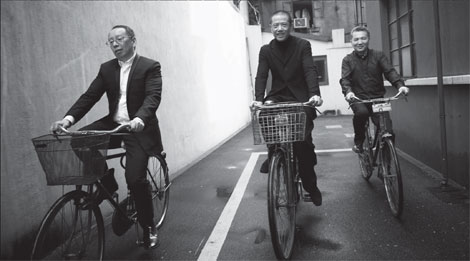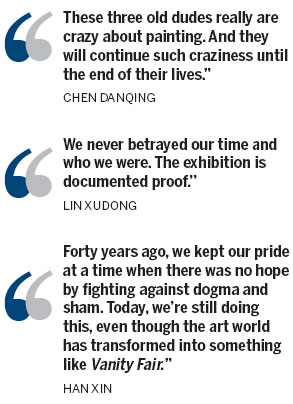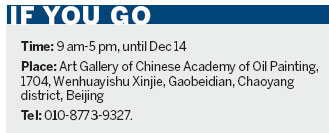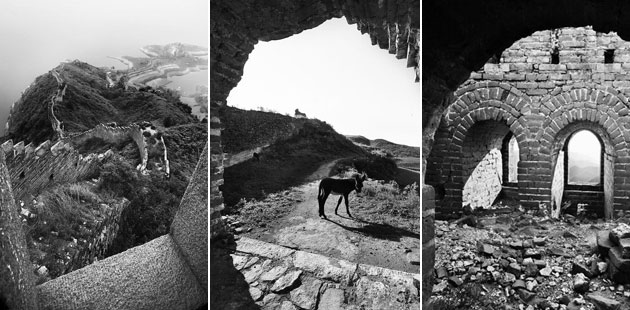The odyssey continues
Updated: 2011-12-06 10:54
By Zhang Zixuan (China Daily)
|
|||||||||
 |
|
(From left) Lin Xudong, Chen Danqing and Han Xin ride bicycles in Shanghai's narrow lanes to retrace the starting point of their four-decade-long friendship and artistic careers. Li Qi / For China Daily |
 |
|
From top: Oil painting Tibet Series by Chen Danqing, oil painting Smoking Strong Man by Lin Xudong, and watercolor Place for Mushrooming (Siberia) by Han Xin. Photos provided to China Daily |
The exhibition Story of 40 Years by a trio of artists who are best friends represents the evolution of Chinese art. Zhang Zixuan reports.
For so many years, a lingering scene has been looping in Chen Danqing's head: Two teenage boys race bicycles in Shanghai's narrow lanes, one surpassing the other, while they laugh and ring their bicycle bells. When they arrive at No 1301 West Huaihai Road, a Western building in the busiest area of the former French Concession, the two shout out at a second floor window. An older teenage boy pops his head out and says: "Come up!"
It was 1971, when the "cultural revolution" (1966-1976) was in full swing. Chen was 18. Han Xin, the other boy on the bicycle, had just turned into 16. And Lin Xudong, the one at the window, was 19.
That year, in the building that was Lin's house, the three school dropouts began their painting odyssey by covertly copying works of Western masters like Diego Velazquez (1599-1660) and Gustave Courbet (1819-1877) from remnants of pictures they had.
Forty years later, the three are still painting.
Recently, the trio dusted off many of the artworks they made over the past four decades and will air them once again at the Art Gallery of Chinese Academy of Oil Painting under the title Story of 40 Years.
The co-exhibition gathers their more than 200 artworks along with old photos and handwritten letters that bear witness to their long-lasting friendship.
The low-key opening ceremony lasted just five minutes and featured no big-name guests. But, even so, hundreds of art enthusiasts crammed into the gallery.
"The exhibition doesn't deliver a message of success. It just delivers sincerity, which is vanishing from today's art world," Chen says.
The artist's formative experiences are fairly well known to the general public.
With just a junior high school diploma, the self-taught artist was admitted as a painting-major postgraduate by the Central Academy of Fine Arts in 1978, after being dispatched to rural Jiangxi province for eight years.
He achieved fame nationwide with his Tibet Series in the early 1980s. Later, he gave up teaching at his alma mater to become a solo artist in New York.
In 2000, Chen returned to become an art doctoral supervisor at Tsinghua University. But in 2004 he submitted his resignation in protest against the rule that talented young painters could be rejected because they failed an English entry exam.
Chen has since criticized the Chinese education system and spoken out on many other social issues.
 |
"My fame has been foisted on me by the public," he says. "Only when I'm with Lin and Han can I be the 100 percent me."
When Chen first came to prominence with his Tibet Series, the public dubbed it the "Chen Danqing Complex", referring to the switch from the Soviet model of painting to a European style.
But Chen insists his awakening to a European consciousness was actually influenced by Lin and Han, especially Lin.
"Lin had the best aesthetic taste among us, yet he maintained the lowest profile," Chen says.
Many years later, Chen learned by chance that Lin was born in the United States and grew up in France until he was age 4, when his father, a nuclear physicist, returned to help the construction of New China.
Lin was the first of the three who dared to portray nudity. He was also the first who prepared to enter the Central Academy of Fine Arts, when art schools were closed and everyone believed the "cultural revolution" would last forever.
But Lin was already 33 when he finally got into his dream school as a print-major postgraduate in 1984. He was the last of the three to be admitted.
"Part of my life experience can only be expressed by painting, while the rest can only be expressed by movies," Lin comments.
 |
From 1995 to 2004, Lin gave up painting and dedicated himself to film. He became a critic of China's fifth-generation directors, and a mentor and partner to the sixth-generation.
In 2004, when Chen resigned his post, Lin quietly quit his job as movie professor at the Communication University of China, where he had been working since graduation.
"I felt the painting studio was calling me back after seeing so many original masterpieces overseas," the 59-year-old says.
Chen says, "Lin values painting so much, but he never tried to hold an exhibition before. You can't find anyone as low-key as Lin."
Han, on the other hand, is the youngest of the three artists and describes himself as outspoken, uninhibited and peacockish.
The artist became famous when he was still a teenager.
In the early 1970s the Gang of Four planned a "reactionary painting exhibition", which was intended as a political strategy to strike out at former premier Zhou Enlai.
Artworks from Lin Fengmian (1900-1991), Liu Haisu (1896-1994) and Feng Zikai (1898-1975) were included in the exhibition. So was a piece by Han.
"I was obsessed by German Expressionism then, so, as a prank, I did a painting of a Chinese soldier with red eyes, red hair and a red uniform," Han recalls.
Many artists wrote self-criticism and shed tears after having their works withdrawn from the exhibition. Han, who was dubbed "wonder child", "shamelessly" asked the organizing committee for tickets, so he could invite all his friends to see his work.
"I was too young to figure out what was really going on. I was just so proud to exhibit my work with so many great masters," Han explains.
Han suffered a setback after the exhibition as his friends - except for Lin and Chen - deserted him.
In 1979, Han was accepted at the Central Academy of Fine Arts as a mural-major postgraduate. One year later, he went to the US with his American ex-wife.
He then got a master's in fine arts from UC Berkeley and gained a footing in the US art world. In 1989, he was invited by the French Institute to be enrolled on a one-year residency at Monet's garden in Giverny, France.
Han says he was always ambitious.
"When I heard about someone who painted well, I found the person, introduced myself and showed him or her my paintings," the 56-year-old says about his "battle-like" way of getting a foot in the door when young.
Even today, Han enjoys acting like a spoiled child in front of his two "elder brothers" - Lin and Chen - and forces them to praise his paintings. They are only too happy to do so.
"Han is a truer artist than us. The painting of his sister at the window looked like genuine School of Paris," Chen says. "He is so full of talent that he doesn't really care about themes or styles. Once he paints, he is willing and able to paint everything."
In 2009, Han returned to China to be with his friends in Beijing.
"Forty years ago, we kept our pride at a time when there was no hope by fighting against dogma and sham. Today, we're still doing this, even though the art world has transformed into something like Vanity Fair," Han says.
Lin says, "We never betrayed our time and who we were. The exhibition is documented proof."
To this, Chen adds, "These three old dudes really are crazy about painting. And they will continue such craziness until the end of their lives."











